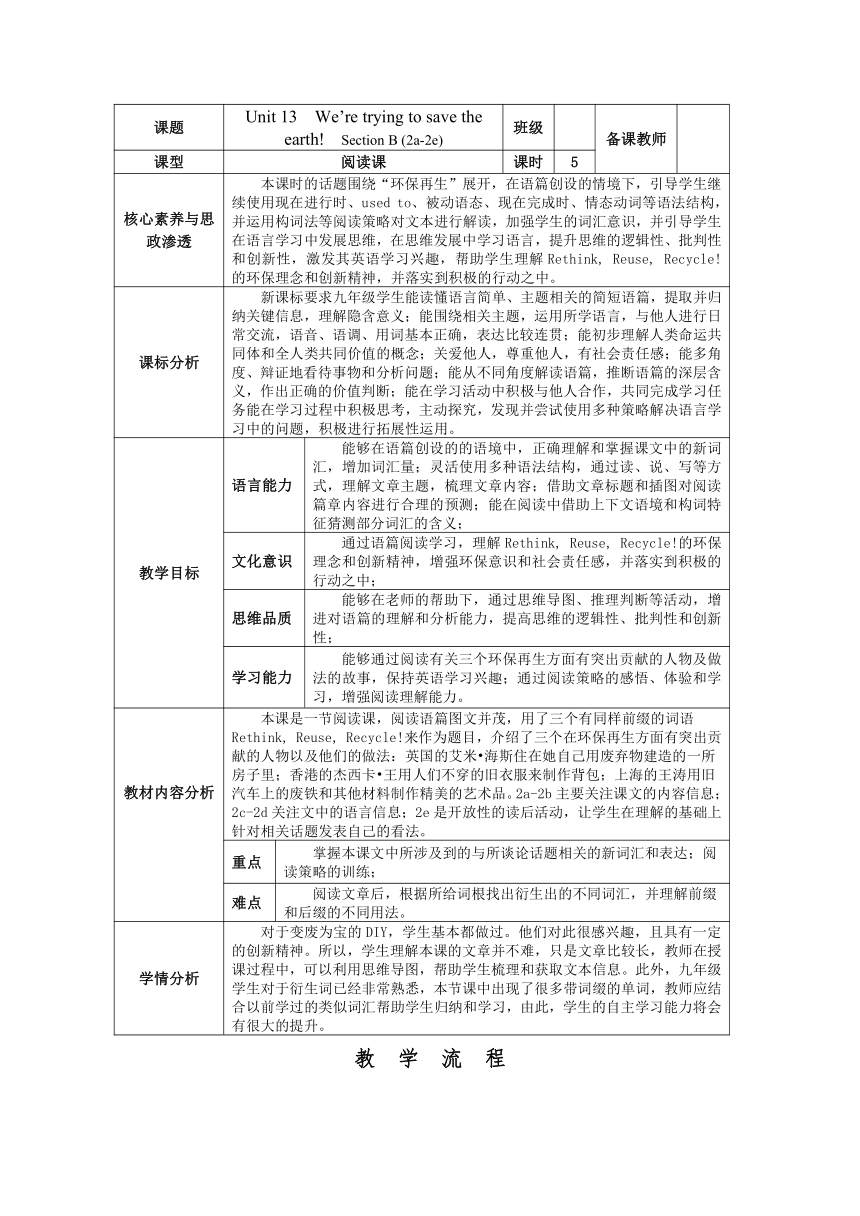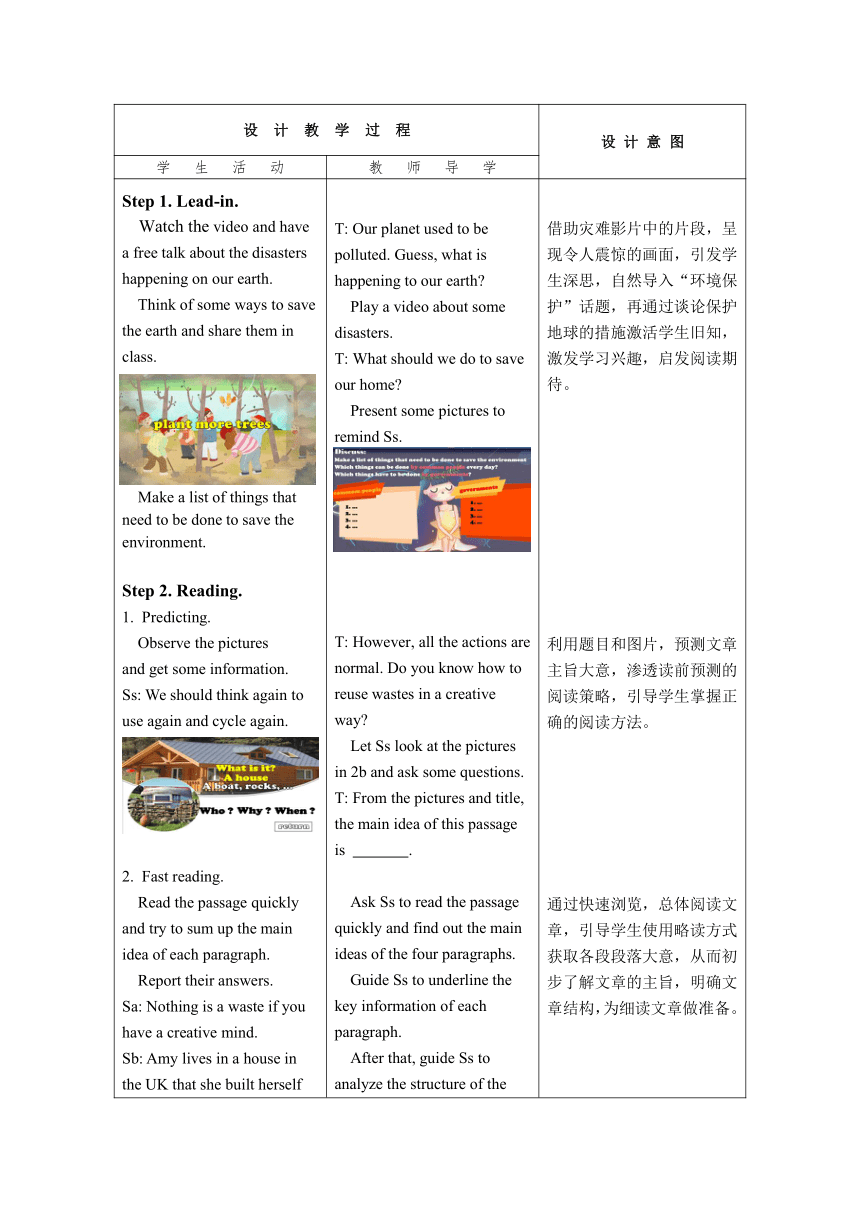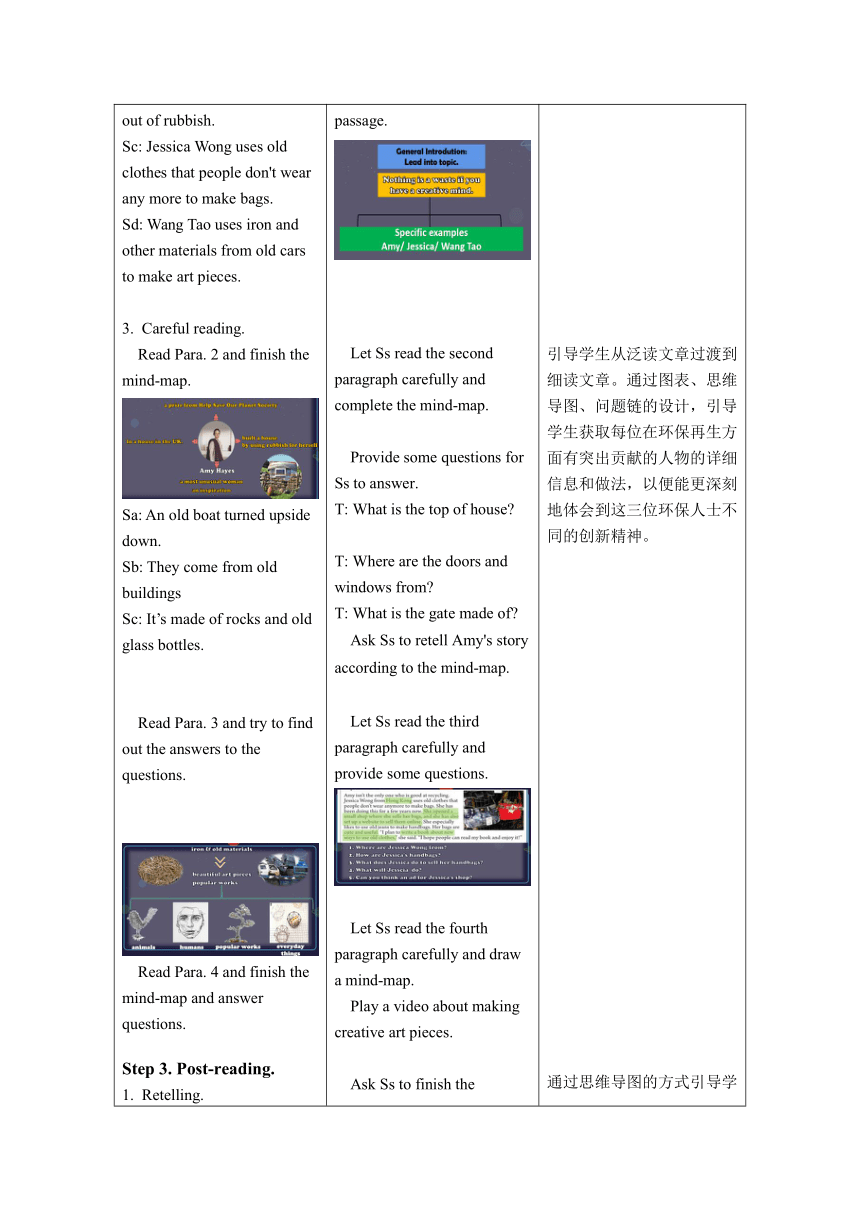【核心素养目标】Unit 13 We’re trying to save the earth! Section B (2a-2e) 表格式教案
文档属性
| 名称 | 【核心素养目标】Unit 13 We’re trying to save the earth! Section B (2a-2e) 表格式教案 |

|
|
| 格式 | docx | ||
| 文件大小 | 2.5MB | ||
| 资源类型 | 教案 | ||
| 版本资源 | 人教新目标(Go for it)版 | ||
| 科目 | 英语 | ||
| 更新时间 | 2024-09-25 16:18:12 | ||
图片预览



文档简介
课题 Unit 13 We’re trying to save the earth! Section B (2a-2e) 班级 备课教师
课型 阅读课 课时 5
核心素养与思政渗透 本课时的话题围绕“环保再生”展开,在语篇创设的情境下,引导学生继续使用现在进行时、used to、被动语态、现在完成时、情态动词等语法结构,并运用构词法等阅读策略对文本进行解读,加强学生的词汇意识,并引导学生在语言学习中发展思维,在思维发展中学习语言,提升思维的逻辑性、批判性和创新性,激发其英语学习兴趣,帮助学生理解Rethink, Reuse, Recycle!的环保理念和创新精神,并落实到积极的行动之中。
课标分析 新课标要求九年级学生能读懂语言简单、主题相关的简短语篇,提取并归纳关键信息,理解隐含意义;能围绕相关主题,运用所学语言,与他人进行日常交流,语音、语调、用词基本正确,表达比较连贯;能初步理解人类命运共同体和全人类共同价值的概念;关爱他人,尊重他人,有社会责任感;能多角度、辩证地看待事物和分析问题;能从不同角度解读语篇,推断语篇的深层含义,作出正确的价值判断;能在学习活动中积极与他人合作,共同完成学习任务能在学习过程中积极思考,主动探究,发现并尝试使用多种策略解决语言学习中的问题,积极进行拓展性运用。
教学目标 语言能力 能够在语篇创设的的语境中,正确理解和掌握课文中的新词汇,增加词汇量;灵活使用多种语法结构,通过读、说、写等方式,理解文章主题,梳理文章内容;借助文章标题和插图对阅读篇章内容进行合理的预测;能在阅读中借助上下文语境和构词特征猜测部分词汇的含义;
文化意识 通过语篇阅读学习,理解Rethink, Reuse, Recycle!的环保理念和创新精神,增强环保意识和社会责任感,并落实到积极的行动之中;
思维品质 能够在老师的帮助下,通过思维导图、推理判断等活动,增进对语篇的理解和分析能力,提高思维的逻辑性、批判性和创新性;
学习能力 能够通过阅读有关三个环保再生方面有突出贡献的人物及做法的故事,保持英语学习兴趣;通过阅读策略的感悟、体验和学习,增强阅读理解能力。
教材内容分析 本课是一节阅读课,阅读语篇图文并茂,用了三个有同样前缀的词语Rethink, Reuse, Recycle!来作为题目,介绍了三个在环保再生方面有突出贡献的人物以及他们的做法:英国的艾米 海斯住在她自己用废弃物建造的一所房子里;香港的杰西卡 王用人们不穿的旧衣服来制作背包;上海的王涛用旧汽车上的废铁和其他材料制作精美的艺术品。2a-2b主要关注课文的内容信息;2c-2d关注文中的语言信息;2e是开放性的读后活动,让学生在理解的基础上针对相关话题发表自己的看法。
重点 掌握本课文中所涉及到的与所谈论话题相关的新词汇和表达;阅读策略的训练;
难点 阅读文章后,根据所给词根找出衍生出的不同词汇,并理解前缀和后缀的不同用法。
学情分析 对于变废为宝的DIY,学生基本都做过。他们对此很感兴趣,且具有一定的创新精神。所以,学生理解本课的文章并不难,只是文章比较长,教师在授课过程中,可以利用思维导图,帮助学生梳理和获取文本信息。此外,九年级学生对于衍生词已经非常熟悉,本节课中出现了很多带词缀的单词,教师应结合以前学过的类似词汇帮助学生归纳和学习,由此,学生的自主学习能力将会有很大的提升。
教 学 流 程
设 计 教 学 过 程 设 计 意 图
学 生 活 动 教 师 导 学
Step 1. Lead-in. Watch the video and have a free talk about the disasters happening on our earth. Think of some ways to save the earth and share them in class. Make a list of things that need to be done to save the environment. Step 2. Reading. Predicting. Observe the pictures and get some information. Ss: We should think again to use again and cycle again. Fast reading. Read the passage quickly and try to sum up the main idea of each paragraph. Report their answers. Sa: Nothing is a waste if you have a creative mind. Sb: Amy lives in a house in the UK that she built herself out of rubbish. Sc: Jessica Wong uses old clothes that people don't wear any more to make bags. Sd: Wang Tao uses iron and other materials from old cars to make art pieces. Careful reading. Read Para. 2 and finish the mind-map. Sa: An old boat turned upside down. Sb: They come from old buildings Sc: It’s made of rocks and old glass bottles. Read Para. 3 and try to find out the answers to the questions. Read Para. 4 and finish the mind-map and answer questions. Step 3. Post-reading. Retelling. Further thinking. Sa: What do Amy, Jessica and Wang Tao have in common Work on 2d. Underline the words and then have conclusion about the rules. Work on 2c. Complete the sentences and read them aloud to check answers. Group work. Think about the environment in their city and finish the chart to give a report. Step 4. Conclusion. Have a summary of what they’ve learned this lesson. T: Our planet used to be polluted. Guess, what is happening to our earth Play a video about some disasters. T: What should we do to save our home Present some pictures to remind Ss. T: However, all the actions are normal. Do you know how to reuse wastes in a creative way Let Ss look at the pictures in 2b and ask some questions. T: From the pictures and title, the main idea of this passage is . Ask Ss to read the passage quickly and find out the main ideas of the four paragraphs. Guide Ss to underline the key information of each paragraph. After that, guide Ss to analyze the structure of the passage. Let Ss read the second paragraph carefully and complete the mind-map. Provide some questions for Ss to answer. T: What is the top of house T: Where are the doors and windows from T: What is the gate made of Ask Ss to retell Amy's story according to the mind-map. Let Ss read the third paragraph carefully and provide some questions. Let Ss read the fourth paragraph carefully and draw a mind-map. Play a video about making creative art pieces. Ask Ss to finish the mind-map and try to retell the whole passage based on it. T: What do Amy, Jessica and Wang Tao have in common T: Even the wastes can bring happiness to people if we have a little creativity. Ask Ss to underline the words in the passage based on the words in 2d. Ask Ss to fill in the blanks with the correct forms of the phrases in 2c. 借助灾难影片中的片段,呈现令人震惊的画面,引发学生深思,自然导入“环境保护”话题,再通过谈论保护地球的措施激活学生旧知,激发学习兴趣,启发阅读期待。 利用题目和图片,预测文章主旨大意,渗透读前预测的阅读策略,引导学生掌握正确的阅读方法。 通过快速浏览,总体阅读文章,引导学生使用略读方式获取各段段落大意,从而初步了解文章的主旨,明确文章结构,为细读文章做准备。 引导学生从泛读文章过渡到细读文章。通过图表、思维导图、问题链的设计,引导学生获取每位在环保再生方面有突出贡献的人物的详细信息和做法,以便能更深刻地体会到这三位环保人士不同的创新精神。 通过思维导图的方式引导学习整合文章主要信息,再次检查学生对文章细节的获取、理解和复述,巩固语言知识,帮助学生梳理文章内容,提升逻辑、创新思维,并通过复述将所学到的语言知识进行内化和输出。 进行情感教育,理解创新精神。 渗透阅读技能教学,引导学生总结和学习构词法,帮助学生在阅读中猜测词义。 在阅读后,对重点词汇和短语进行运用,在对文本进行改写的同时,达成知识目标。 引导学生对所学的保护环境措施进行归纳和分类,培养学生分析问题和解决问题的能力。
课 时 达 标 检 测
I.根据句意和汉语提示写出所缺的单词或短语。 1. We will wait for the school bus at the (大门). 2. Don’t (扔掉) these old books. They are good books. You can give them away to poor children. 3. The white building is going to be (摧毁). 4. I will (归还) the latest novel to you tomorrow. 5. Don’t put the box (上下颠倒). There is something valuable in it. Ⅱ.阅读理解。 Andrew Holleman, a 12-year-old boy, loved playing in the open land near his home. The land was wet and forested, and made a home for the birds, other animals and many different plants. It made the perfect place for him to study and get to know the nature. He had seen some red-tailed hawks, red foxes, wood turtles and other animals. He also found special native flowers. Suddenly it was announced that the “empty” land would be improved by a lot of houses on it. The plants would be removed, the animals would run away and most would probably die. Then the wet soil (土壤) would be covered with extra grounds. When he heard about the news, he was not happy. He was very worried that the land and water would be polluted. Andrew wrote down clearly all the research he had done about the area, and how the houses would affect (影响) the local environment. He sent letters to members of local government and television reporters. He also called on his neighbors to oppose the building of the houses. Although he was only 12 years old, he had the courage and wisdom of a person much older. Andrew’s teachers described him as gentle, shy and active. His classmates also admired how much he knew about local animals and plants, and the environment. Each day after school, Andrew went door-to-door, to ask the people to sign (签名), who did not want the houses to be built. In only one month, he got the signatures of 250 people. In the end, the land remained a safe place for birds, animals and plants that belonged there. Andrew won many prizes for his brave and great work to stop the houses being built, and thus help save the environment. 1. The passage is mainly about _______. A. 250 people who signed to help Andrew B. a brave boy who cared for the environment C. the open land that suited animals and plants D. the research of improving the environment 2. The underlined word “oppose” in the passage probably means _______. A. support B. dislike C. disagree D. prefer 3. Andrew was very worried because _______. A. the animals would be killed B. new houses would be built on the open land C. not all the neighbors were going to sign D. the local government made a right decision 4. According to the passage, Andrew _______. A. was good at going door-to-door B. got in no touch with the reporters C. usually acted like a person much older D. was praised by his teachers and classmates 5. We can infer (推测) that _______. A. the land would remain as it used to be B. the open land would be built into a park C. the neighbors would have to move away D. Andrew would soon work for the government
课 时 教 学 设 计 尾 页
板 书 设 计
Unit 13 We’re trying to save the earth! Section B (2a-2e)
作 业 设 计
Level A What can we do to protect the wild animals and save the environment List as many good ideas as you can think of and share them with your classmates.
Level B Draw a mind-map of the passage.
教 学 反 思
第 页
课型 阅读课 课时 5
核心素养与思政渗透 本课时的话题围绕“环保再生”展开,在语篇创设的情境下,引导学生继续使用现在进行时、used to、被动语态、现在完成时、情态动词等语法结构,并运用构词法等阅读策略对文本进行解读,加强学生的词汇意识,并引导学生在语言学习中发展思维,在思维发展中学习语言,提升思维的逻辑性、批判性和创新性,激发其英语学习兴趣,帮助学生理解Rethink, Reuse, Recycle!的环保理念和创新精神,并落实到积极的行动之中。
课标分析 新课标要求九年级学生能读懂语言简单、主题相关的简短语篇,提取并归纳关键信息,理解隐含意义;能围绕相关主题,运用所学语言,与他人进行日常交流,语音、语调、用词基本正确,表达比较连贯;能初步理解人类命运共同体和全人类共同价值的概念;关爱他人,尊重他人,有社会责任感;能多角度、辩证地看待事物和分析问题;能从不同角度解读语篇,推断语篇的深层含义,作出正确的价值判断;能在学习活动中积极与他人合作,共同完成学习任务能在学习过程中积极思考,主动探究,发现并尝试使用多种策略解决语言学习中的问题,积极进行拓展性运用。
教学目标 语言能力 能够在语篇创设的的语境中,正确理解和掌握课文中的新词汇,增加词汇量;灵活使用多种语法结构,通过读、说、写等方式,理解文章主题,梳理文章内容;借助文章标题和插图对阅读篇章内容进行合理的预测;能在阅读中借助上下文语境和构词特征猜测部分词汇的含义;
文化意识 通过语篇阅读学习,理解Rethink, Reuse, Recycle!的环保理念和创新精神,增强环保意识和社会责任感,并落实到积极的行动之中;
思维品质 能够在老师的帮助下,通过思维导图、推理判断等活动,增进对语篇的理解和分析能力,提高思维的逻辑性、批判性和创新性;
学习能力 能够通过阅读有关三个环保再生方面有突出贡献的人物及做法的故事,保持英语学习兴趣;通过阅读策略的感悟、体验和学习,增强阅读理解能力。
教材内容分析 本课是一节阅读课,阅读语篇图文并茂,用了三个有同样前缀的词语Rethink, Reuse, Recycle!来作为题目,介绍了三个在环保再生方面有突出贡献的人物以及他们的做法:英国的艾米 海斯住在她自己用废弃物建造的一所房子里;香港的杰西卡 王用人们不穿的旧衣服来制作背包;上海的王涛用旧汽车上的废铁和其他材料制作精美的艺术品。2a-2b主要关注课文的内容信息;2c-2d关注文中的语言信息;2e是开放性的读后活动,让学生在理解的基础上针对相关话题发表自己的看法。
重点 掌握本课文中所涉及到的与所谈论话题相关的新词汇和表达;阅读策略的训练;
难点 阅读文章后,根据所给词根找出衍生出的不同词汇,并理解前缀和后缀的不同用法。
学情分析 对于变废为宝的DIY,学生基本都做过。他们对此很感兴趣,且具有一定的创新精神。所以,学生理解本课的文章并不难,只是文章比较长,教师在授课过程中,可以利用思维导图,帮助学生梳理和获取文本信息。此外,九年级学生对于衍生词已经非常熟悉,本节课中出现了很多带词缀的单词,教师应结合以前学过的类似词汇帮助学生归纳和学习,由此,学生的自主学习能力将会有很大的提升。
教 学 流 程
设 计 教 学 过 程 设 计 意 图
学 生 活 动 教 师 导 学
Step 1. Lead-in. Watch the video and have a free talk about the disasters happening on our earth. Think of some ways to save the earth and share them in class. Make a list of things that need to be done to save the environment. Step 2. Reading. Predicting. Observe the pictures and get some information. Ss: We should think again to use again and cycle again. Fast reading. Read the passage quickly and try to sum up the main idea of each paragraph. Report their answers. Sa: Nothing is a waste if you have a creative mind. Sb: Amy lives in a house in the UK that she built herself out of rubbish. Sc: Jessica Wong uses old clothes that people don't wear any more to make bags. Sd: Wang Tao uses iron and other materials from old cars to make art pieces. Careful reading. Read Para. 2 and finish the mind-map. Sa: An old boat turned upside down. Sb: They come from old buildings Sc: It’s made of rocks and old glass bottles. Read Para. 3 and try to find out the answers to the questions. Read Para. 4 and finish the mind-map and answer questions. Step 3. Post-reading. Retelling. Further thinking. Sa: What do Amy, Jessica and Wang Tao have in common Work on 2d. Underline the words and then have conclusion about the rules. Work on 2c. Complete the sentences and read them aloud to check answers. Group work. Think about the environment in their city and finish the chart to give a report. Step 4. Conclusion. Have a summary of what they’ve learned this lesson. T: Our planet used to be polluted. Guess, what is happening to our earth Play a video about some disasters. T: What should we do to save our home Present some pictures to remind Ss. T: However, all the actions are normal. Do you know how to reuse wastes in a creative way Let Ss look at the pictures in 2b and ask some questions. T: From the pictures and title, the main idea of this passage is . Ask Ss to read the passage quickly and find out the main ideas of the four paragraphs. Guide Ss to underline the key information of each paragraph. After that, guide Ss to analyze the structure of the passage. Let Ss read the second paragraph carefully and complete the mind-map. Provide some questions for Ss to answer. T: What is the top of house T: Where are the doors and windows from T: What is the gate made of Ask Ss to retell Amy's story according to the mind-map. Let Ss read the third paragraph carefully and provide some questions. Let Ss read the fourth paragraph carefully and draw a mind-map. Play a video about making creative art pieces. Ask Ss to finish the mind-map and try to retell the whole passage based on it. T: What do Amy, Jessica and Wang Tao have in common T: Even the wastes can bring happiness to people if we have a little creativity. Ask Ss to underline the words in the passage based on the words in 2d. Ask Ss to fill in the blanks with the correct forms of the phrases in 2c. 借助灾难影片中的片段,呈现令人震惊的画面,引发学生深思,自然导入“环境保护”话题,再通过谈论保护地球的措施激活学生旧知,激发学习兴趣,启发阅读期待。 利用题目和图片,预测文章主旨大意,渗透读前预测的阅读策略,引导学生掌握正确的阅读方法。 通过快速浏览,总体阅读文章,引导学生使用略读方式获取各段段落大意,从而初步了解文章的主旨,明确文章结构,为细读文章做准备。 引导学生从泛读文章过渡到细读文章。通过图表、思维导图、问题链的设计,引导学生获取每位在环保再生方面有突出贡献的人物的详细信息和做法,以便能更深刻地体会到这三位环保人士不同的创新精神。 通过思维导图的方式引导学习整合文章主要信息,再次检查学生对文章细节的获取、理解和复述,巩固语言知识,帮助学生梳理文章内容,提升逻辑、创新思维,并通过复述将所学到的语言知识进行内化和输出。 进行情感教育,理解创新精神。 渗透阅读技能教学,引导学生总结和学习构词法,帮助学生在阅读中猜测词义。 在阅读后,对重点词汇和短语进行运用,在对文本进行改写的同时,达成知识目标。 引导学生对所学的保护环境措施进行归纳和分类,培养学生分析问题和解决问题的能力。
课 时 达 标 检 测
I.根据句意和汉语提示写出所缺的单词或短语。 1. We will wait for the school bus at the (大门). 2. Don’t (扔掉) these old books. They are good books. You can give them away to poor children. 3. The white building is going to be (摧毁). 4. I will (归还) the latest novel to you tomorrow. 5. Don’t put the box (上下颠倒). There is something valuable in it. Ⅱ.阅读理解。 Andrew Holleman, a 12-year-old boy, loved playing in the open land near his home. The land was wet and forested, and made a home for the birds, other animals and many different plants. It made the perfect place for him to study and get to know the nature. He had seen some red-tailed hawks, red foxes, wood turtles and other animals. He also found special native flowers. Suddenly it was announced that the “empty” land would be improved by a lot of houses on it. The plants would be removed, the animals would run away and most would probably die. Then the wet soil (土壤) would be covered with extra grounds. When he heard about the news, he was not happy. He was very worried that the land and water would be polluted. Andrew wrote down clearly all the research he had done about the area, and how the houses would affect (影响) the local environment. He sent letters to members of local government and television reporters. He also called on his neighbors to oppose the building of the houses. Although he was only 12 years old, he had the courage and wisdom of a person much older. Andrew’s teachers described him as gentle, shy and active. His classmates also admired how much he knew about local animals and plants, and the environment. Each day after school, Andrew went door-to-door, to ask the people to sign (签名), who did not want the houses to be built. In only one month, he got the signatures of 250 people. In the end, the land remained a safe place for birds, animals and plants that belonged there. Andrew won many prizes for his brave and great work to stop the houses being built, and thus help save the environment. 1. The passage is mainly about _______. A. 250 people who signed to help Andrew B. a brave boy who cared for the environment C. the open land that suited animals and plants D. the research of improving the environment 2. The underlined word “oppose” in the passage probably means _______. A. support B. dislike C. disagree D. prefer 3. Andrew was very worried because _______. A. the animals would be killed B. new houses would be built on the open land C. not all the neighbors were going to sign D. the local government made a right decision 4. According to the passage, Andrew _______. A. was good at going door-to-door B. got in no touch with the reporters C. usually acted like a person much older D. was praised by his teachers and classmates 5. We can infer (推测) that _______. A. the land would remain as it used to be B. the open land would be built into a park C. the neighbors would have to move away D. Andrew would soon work for the government
课 时 教 学 设 计 尾 页
板 书 设 计
Unit 13 We’re trying to save the earth! Section B (2a-2e)
作 业 设 计
Level A What can we do to protect the wild animals and save the environment List as many good ideas as you can think of and share them with your classmates.
Level B Draw a mind-map of the passage.
教 学 反 思
第 页
同课章节目录
- Unit 1 How can we become good learners.
- Section A
- Section B
- Unit 2 I think that mooncakes are delicious!
- Section A
- Section B
- Unit 3 Could you please tell me where the restroom
- Section A
- Section B
- Unit 4 I used to be afraid of the dark.
- Section A
- Section B
- Unit 5 What are the shirts made of?
- Section A
- Section B
- Review of Units 1-5
- Unit 6 When was it invented?
- Section A
- Section B
- Unit 7 Teenagers should be allowed to choose their
- Section A
- Section B
- Unit 8 It must belong to Carla.
- Section A
- Section B
- Unit 9 I like music that I can dance to.
- Section A
- Section B
- Unit 10 You're supposed to shake hands.
- Section A
- Section B
- Review of Units 6-10
- Unit 11 Sad movies make me cry.
- Section A
- Section B
- Unit 12 Life is full of the unexpected
- Section A
- Section B
- Unit 13 We're trying to save the earth!
- Section A
- Section B
- Unit 14 I remember meeting all of you in Grade 7.
- Section A
- Section B
- Review of Units 11-14
